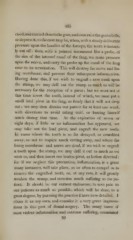Page 469 - My FlipBook
P. 469
;
465
cised, and carried close to the gum, and even raise the gum a little,
or depress it, as the case may be, when, with a steady deliberate
pressure upon the handles of the forceps, the tooth is instant-
ly cut off: then, with a pointed instrument like a probe, of
the size of the internal canal of the fang, we make pressure
upon the nerve, and carry the probe up the canal of the fang
near to its termination. This will destroy the nerve and lin-
ing membrane, and prevent their subsequent inflammation.
Having done this, if we wish to engraft a new tooth upon
the stump, we may drill out the stump as much as will be
necessary for the reception of a pivot ; but we must not at
this time insert the tooth, instead of which, we must put a
small lead pivot in the fang, so firmly that it will not drop
out ; we may then dismiss our patient for at least one week,
with directions to avoid taking cold, or heating himself
much during that time. At the expiration of seven or
eight days, if little or no inflammation has appeared, we
may take out the lead pivot, and engraft the new tooth.
In cases where the tooth is so far decayed, or crumbled
away, as not to require much cutting away, and where the
lining membrane and nerve are dead, if we wish to engraft
a tooth upon the stump, we may drill it out as much as we
wish to, and then insert our leaden pivot, as before directed
for if we neglect this precaution, inflammation, in a great
many instances, will take place, so as often to compel us to
remove the engrafted tooth, or, at any rate, it will greatly
weaken the stump, and occasion much suffering to the pa-
tient. It should be our earnest endeavour, to save pain to
our patients as much as possible, which will be done, to a
treat degree, by pursuing the practice I have here detailed. I
claim it as my own, and consider it a very great improve-
ment in this part of dental-surgery. The many cases of
most violent inflammation and extreme suffering, occasioned
59
465
cised, and carried close to the gum, and even raise the gum a little,
or depress it, as the case may be, when, with a steady deliberate
pressure upon the handles of the forceps, the tooth is instant-
ly cut off: then, with a pointed instrument like a probe, of
the size of the internal canal of the fang, we make pressure
upon the nerve, and carry the probe up the canal of the fang
near to its termination. This will destroy the nerve and lin-
ing membrane, and prevent their subsequent inflammation.
Having done this, if we wish to engraft a new tooth upon
the stump, we may drill out the stump as much as will be
necessary for the reception of a pivot ; but we must not at
this time insert the tooth, instead of which, we must put a
small lead pivot in the fang, so firmly that it will not drop
out ; we may then dismiss our patient for at least one week,
with directions to avoid taking cold, or heating himself
much during that time. At the expiration of seven or
eight days, if little or no inflammation has appeared, we
may take out the lead pivot, and engraft the new tooth.
In cases where the tooth is so far decayed, or crumbled
away, as not to require much cutting away, and where the
lining membrane and nerve are dead, if we wish to engraft
a tooth upon the stump, we may drill it out as much as we
wish to, and then insert our leaden pivot, as before directed
for if we neglect this precaution, inflammation, in a great
many instances, will take place, so as often to compel us to
remove the engrafted tooth, or, at any rate, it will greatly
weaken the stump, and occasion much suffering to the pa-
tient. It should be our earnest endeavour, to save pain to
our patients as much as possible, which will be done, to a
treat degree, by pursuing the practice I have here detailed. I
claim it as my own, and consider it a very great improve-
ment in this part of dental-surgery. The many cases of
most violent inflammation and extreme suffering, occasioned
59


